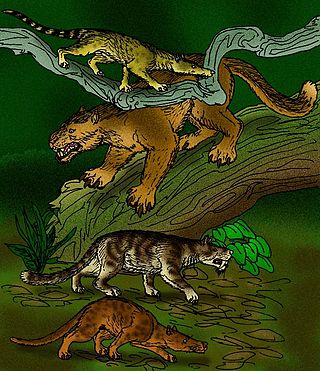
Amphicyonidae is an extinct family of terrestrial carnivorans belonging to the suborder Caniformia. They first appeared in North America in the middle Eocene, spread to Europe by the late Eocene, and further spread to Asia and Africa by the early Miocene. They had largely disappeared worldwide by the late Miocene, with the latest recorded species at the end of the Miocene in Africa. They were among the first carnivorans to evolve large body size. Amphicyonids are colloquially referred to as "bear-dogs".

Creodonta is a former order of extinct carnivorous placental mammals that lived from the early Paleocene to the late Miocene epochs in North America, Europe, Asia and Africa. Originally thought to be a single group of animals ancestral to the modern Carnivora, this order is now usually considered a polyphyletic assemblage of two different groups, the oxyaenids and the hyaenodonts, not a natural group. Oxyaenids are first known from the Palaeocene of North America, while hyaenodonts hail from the Palaeocene of Africa.

Megistotherium is an extinct genus of hyaenodont belonging to the family Hyainailouridae that lived in Africa.

Percrocuta is an extinct genus of hyena. It lived in Europe, Asia, and Africa, during the Miocene epoch.

Barbourofelidae is an extinct family of carnivorans of the suborder Feliformia, sometimes known as false saber-toothed cats, that lived in North America, Eurasia and Africa during the Miocene epoch and existed for about 7.9 million years. Thought to be an independent lineage from the Nimravidae and Machairodontinae, which had all attained elongated canines, recent research argues that it may be a subfamily of the Nimravidae, extending its biochronological range into the Miocene, although this issue is not yet fully resolved.

Dissopsalis is a genus of teratodontine hyaenodonts of the tribe Dissopsalini. The older species, D. pyroclasticus, lived in Kenya during the middle Miocene, while the type species, D. carnifex, lived in Pakistan and India during the middle to late Miocene.

Palaeogale is an extinct genus of carnivorous mammal known from the Late Eocene, Oligocene, and Early Miocene of North America, Europe, and Eastern Asia. A small carnivore often associated with the mustelids, Palaeogale might have been similar to living genets, civets, and linsangs.

Lesmesodon is an extinct genus of placental mammals from extinct family Proviverridae within extinct superfamily Hyaenodontoidea, that lived during the Early to Middle Eocene. It was found in France and in the Messel Pit in Germany. Lesmesodon was a weasel-sized carnivorous mammal.

Hyainailouros ("hyena-cat") is an extinct polyphyletic genus of hyaenodont belonging to the family Hyainailouridae that lived during the early to middle Miocene, of which there were at least three species spread across Europe, Africa, and Asia.

Limnocyon is an extinct paraphyletic genus of limnocyonid hyaenodonts that lived in North America during the middle Eocene. Fossils of this animal have been found in California, Utah and Wyoming.

Hyaenodonta is an extinct order of hypercarnivorous placental mammals of clade Pan-Carnivora from mirorder Ferae. Hyaenodonts were important mammalian predators that arose during the early Paleocene in Europe and persisted well into the late Miocene.

Hyainailouridae ("hyena-cats") is a family of extinct predatory mammals within the superfamily Hyainailouroidea within extinct order Hyaenodonta. Hyaenodontids arose during the middle Eocene and persisted well into the middle Miocene. Fossils of this group have been found in Asia, Africa, North America and Europe.

Teratodontinae is a subfamily of extinct hyaenodonts. Fossil remains of these mammals are known from Middle Eocene to Late Miocene deposits in Africa, the Arabian Peninsula, and Asia.
Isohyaenodon is an extinct polyphyletic genus of hyainailourid hyaenodont mammal from the subfamily Hyainailourinae). Remains are known from early to middle Miocene deposits in Kenya, East Africa.

Limnocyoninae is a subfamily of extinct predatory mammals from extinct order Hyaenodonta. Fossil remains of these mammals are known from late Paleocene to late Eocene deposits in North America and Asia. Limnocyonines had only two molars in the upper and lower dentition.

Dissopsalini is an extinct tribe of teratodontid hyaenodonts. Fossil remains of these mammals are known from early to late Miocene deposits in Asia and Africa.

Apterodontinae is an extinct subfamily of hyainailourid hyaenodonts that lived in Africa and Europe during the late Eocene to middle Oligocene.

Hyainailourinae ("hyena-cats") is an extinct subfamily of hyainailourid hyaenodonts that lived in Africa, Asia, North America and Europe from the middle Eocene to middle Miocene. They appeared in Africa about 47.8 Ma ago and soon after spread as far as East Asia.
Asilifelis is an extinct genus of small felid that lived in what is now Kenya during the Early Miocene. Despite its fragmentary remains, it is remarkable because of its small size and advanced dentition. It contains a single species, Asilifelis cotae.
Namibiocyon is an extinct genus of carnivoran mammals, belonging to the family Amphicyonidae, that lived in Namibia during the Early Miocene epoch. Before the erection of this taxon in 2022, the type and only species, N. ginsburgi, had been assigned to a variety of other genera. It is notable for its adaptions toward hypercarnivory.











